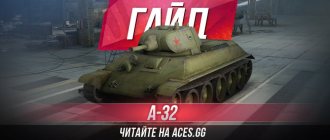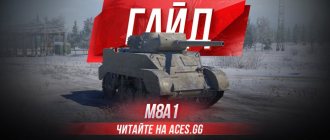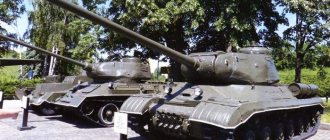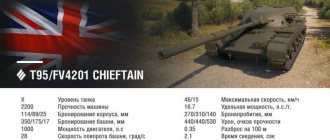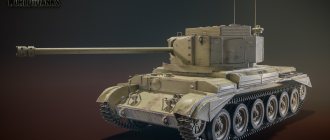Hello everyone and welcome to the aces.gg portal! Today we will talk about an incredibly cool car, a very rare guest of randomness, a heavy premium tank of the fifth level of the USSR branch - this is the KV-220-2 guide.
Why is this car so rare? It’s very simple to explain, now it’s almost impossible to get it and only 14,000 players have it in the hangar, even a little less. Of course, there is a chance that Wargaming will make some kind of promotion to get the KV-220-2, but this has not happened for a long time.
By the way, this tank has a twin brother – KV-220-2 Beta-Test. It is absolutely identical in parameters and has only two differences: 1. A beautiful red letter “T” on the tower, surrounded by a circle; 2. It’s definitely impossible to get it anymore, since it was issued only to those people who took part in the closed beta test. Regarding what both of these machines are, we can say that both of them are promotional and at the same time premium, and we will look at a detailed overview of the characteristics of the KV-220-2 a little lower.
TTX KV-220-2
Considering the characteristics of the KV-220-2, the first thing I want to talk about is its armor. This parameter of the tank is simply excellent; it is the most armored vehicle at the fifth level, if you touch on the hull. We can successfully tank all our classmates even sideways, and when positioned in a diamond formation, even opponents at a higher level have difficulty penetrating us.
However, the KV-220-2 WoT also has a weak spot, and this is the turret. If the gun mantlet sometimes knocks something off, then by shooting at the side, and even more so at the stern, the enemy will always penetrate us. By the way, this heavyweight has a preferential level of fighting, which is also very important; it is extremely comfortable to play on. I would like to note that this vehicle has rather large hull dimensions, it is very long, but the armor completely compensates for this drawback and it is mainly artillery that is to be feared. At the same time, our turret is small compared to the hull, and this is good.
In terms of mobility, everything is not so cool, but what do you want from a heavy tank. It's not too slow, but it doesn't have much speed either. Otherwise, there is quite a good margin of safety and poor visibility typical of USSR heavyweights.
Review
The tank does not need pumping, because it is prem.
Armament
Our gun is completely stock. If the KV-1 has a choice in armament (There is a high explosive, a hole puncher, etc.), then we do not have a wide choice at all. Our tank features a 76mm gun. What upset me most was the penetration of our tank. 99mm for level 5 is quite small. If you look at it this way, we have good armor, but the gun is not very good. This weapon is not very penetrating and not very fast-firing. And the most irritating thing is the speed of the projectile. Fairly slow flight speed for such a gun. Because of the gun, they took pity on our tank and assigned it a reduced combat level. But even with all the jambs of the gun. In skillful hands, a tank can easily bend the sandbox. Unfortunately, to break through some tanks you will need gold.
Armor
You won’t find much stronger armor than our tank at level 5. The tank takes you back to the days when armor meant something.
The tank's armor is simply amazing. The side is 100 mm, the upper and lower armor plates are 100 mm each. But don’t forget about various weakened zones: hatches, machine gun terminals, etc. If you become a romo-mob, almost no one will be able to break through you. If you look at it this way, then at level 5 most of the players do not have experience in breaking through such “monsters”. You are guaranteed constant ricochets from enemies.
It is also worth paying attention to the dimensions of the tank. The tank is simply huge. Compared to the KV-1, our tank is an order of magnitude longer than its counterpart. The increased length of this tank is due to the weight of the gun. Which was specially developed for this tank.
The tower unfortunately has less armor. But it breaks through quite rarely, and then only in skirmishes with an experienced enemy.
Mobility
The maximum speed of our tank is only 33 km/h. At the same time, the mass of our tank is 62 tons, and the engine power is 850 hp.
In battle, our tank slowly but surely crawls towards the target. The turning speed of our tank's chassis is 20 deg/s - this is quite low. The tank turns heavily and lazily. It will be easy for small and fast enemies to “carousel” our tank, but they are unlikely to be able to penetrate it.
gun
As for the weapons, this aspect of the tank is at least interesting. The fact is that the gun has rather low one-time damage and a rather poor armor penetration parameter, so you need to carry gold shells (especially for battles against level 6).
Otherwise, the KV-220-2 gun has an increased rate of fire, but the damage per minute is still low - approximately 1540 units. But the gun has excellent declination angles, 8 degrees down and 24 degrees up.
As for accuracy, our spread is too large, stabilization is also poor, but the gun is brought down quickly.
Additionally
We take it with us
Everything is as usual :
We install the equipment
Reinforced aiming drives - to reduce aiming time
Improved ventilation increases crew skills
Coated optics - we have poor visibility, so we install it to increase visibility.
We take some of the shells with us.
100 pieces.
20 pcs. (Depending on your finances.)
Tactics for playing the KV-220-2
As mentioned above, this vehicle has excellent armor; it is a real heavy tank with all its advantages and disadvantages. For this reason, we feel great on the first line. On the KV-220-2, combat tactics consist of getting closer to the enemy and tanking damage; the more guns are pointed at us, the better it is for our allies.
However, we can’t just leave and have everyone shoot at us. You need to take an advantageous position, showing only part of your corps from behind cover, ideally tanking in a reverse diamond shape. In this case, it is very difficult to penetrate us, and we, in turn, will fire with impunity and roll back into cover. At the same time, it is very important to take care of your turret, because anyone can shoot through the KV-220-2 World of Tanks here.
Try not to let the enemy's maneuverable and fast tanks get close to you, they can easily carousel us and then the path to the hangar will inevitably get closer. It is better if we are covered by a couple of allies, and of course, beware of enemy artillery.
If you have such an opportunity, the KV-220-2 is definitely worth taking. This tank is not just rare, it is very strong, brings a lot of fun and excitement to every battle and can farm.
Prototypes in battle. Heavy tank KV-220
Soon after the start of mass production of the KV-1 heavy tank, the leadership of the People's Commissariat of Defense and the Council of People's Commissars decided to continue work in this direction and initiated several similar projects. The main goal of this work was to create a new heavy tank, the armament and protection of which would be superior to the armor and gun of the existing KV-1. On June 17, 1940, a resolution was issued by the Council of People's Commissars, according to which, over the coming months, it was necessary to design and build four new tanks based on the KV-1, each of which would embody one of the selected concepts for the development of a line of heavy tanks. The Kirov Plant was required to assemble two KV-1 tanks with thicker armor (90 millimeters) and different weapons—76 and 85 mm cannons—by November 1. Later, by December 1, the plant was supposed to make two tanks with even thicker 100 mm armor and the same set of weapons. It was assumed that the production of four armored vehicles with different protection and different weapons would make it possible to determine the most promising combination of armor and gun. Due to production reasons, only two new heavy tanks could be compared. In early November, several days late, the Kirov Plant completed production of a tank with 90 mm armor and a 76 mm F-32 cannon. It received the designation T-150. The second tank, called T-220, left the workshop exactly a month later. It had 100 mm thick armor and an 85 mm F-30 gun.
The T-220 tank, better known now as the KV-220, was a modernized and modified KV-1. According to some reports, the T-220 project also appeared in military acceptance documents under the name KV-220-1. The design of the new heavy tank in its main points corresponded to the design of the original KV-1. At the same time, the requirements for increasing the level of protection entailed changes in weight and size. The main plates of the welded armored hull (frontal parts, sides and rear) had a thickness of 100 millimeters. In addition, a pair of frontal plates were slightly thinner - 80 mm. The roof and bottom of the armored chassis were made from sheets with a thickness of 30 to 40 millimeters. When strengthening the armor, the designers of the Leningrad Kirov Plant took into account the need to preserve the internal volumes of the armored hull. Therefore, the dimensions of the control compartment, combat compartment and engine compartment remained the same, and the additional thickness of the armor affected only the external dimensions of the tank.
Calculations have shown that with such an increase in armor, the tank will become heavier to 62-63 tons, which is why it will need a new engine. To accommodate a more powerful engine, the armored hull had to be lengthened by more than two meters, from 6675 to 8830 millimeters. The width has increased slightly. The increased length of the hull was compensated for by an additional support roller on each side and fourth support rollers. The design of the chassis remains the same - road wheels with individual torsion bar suspension, a idler wheel in front and a drive wheel at the rear.
To maintain the driving performance of the KV-220 tank, at least at the level of the original KV-1, it was equipped with a new diesel engine. Instead of the old 500-horsepower engine, the KV-220 was equipped with a new V-5 with a capacity of 700 horsepower. Thanks to the new engine, the specific power of the tank remained at the level of the KV-1 - 11-12 hp. per ton. Speed characteristics also remained the same - maximum speed on the highway is 33-34 km/h and up to 20-22 km/h over rough terrain. The estimated range of the KV-220 tank was 200 kilometers on the highway and up to 150 on rough terrain.
When developing the turret for the new tank, some difficulties arose. The dimensions of the breech of the 85-mm F-30 cannon did not allow it to fit into the volume of the original turret of the KV-1 tank. The use of a turret from the KV-2 tank, in turn, was considered inappropriate due to the not very favorable distribution of internal space. Therefore, it was necessary to design a new tower, the design of which used developments from two previous projects. The hexagonal armored unit was noticeably larger than the turret of the KV-1 tank, but at the same time much smaller than the KV-2 turret. The frontal parts of the turret were 90 millimeters thick, the sides and rear were 75 mm thick. Based on the experience of the KV-2 tank, an additional hatch was provided on the KV-220 turret on the rear armor plate, intended for servicing the gun and loading ammunition. It is noteworthy that thanks to the new turret, the KV-220 was approximately 40 centimeters lower than its predecessor, the KV-1.
For aiming and monitoring the situation, a PT-1 commander's panorama, a PT-6I periscope sight, and a TOD-6 gunner's telescopic sight were installed in the turret of the KV-220 tank. The tank was equipped with an intercom and a KRSTB radio station, taking into account the possibility of using the 71-TK-3 station instead.
Inside the fighting compartment it was possible to place 91 unitary shells for the main gun. One DT machine gun of 7.62 mm caliber was paired with the 85 mm cannon. Two more of the same machine guns were placed on the turret of the commander’s cupola and in a ball mount on the front plate of the hull. The total ammunition load of all three machine guns is 4032 rounds (64 disc magazines). When used by the troops, it was supposed to issue submachine guns to the crew for self-defense. The composition of the crew of the KV-220 tank corresponded to the crew of the KV-2: driver, gunner-radio operator, commander, loader and his assistant.
In January 1941, the experimental KV-220 tank was ready for testing. However, on the last day of this month, during the first trip to the test site, an engine breakdown occurred, which delayed the test schedule. After repairs, for the first few months the prototype of the new heavy tank could only travel around the test site and demonstrate its driving performance. As it turned out at the very beginning of the tests, the F-30 gun was not ready for fire tests. Both the gun itself and its suspension devices needed fine-tuning, which took a lot of time.
It is worth noting that the experimental KV-220 tank did not acquire a ready-to-fire gun as a result. Work on the gun dragged on until the spring of 1941, and by that time the design bureau of V.G. Grabina received several higher priority tasks. After the KV-220 showed all its capabilities except combat, they decided to use it in the KV-3 project. In order to test the possibility of using existing technical solutions on new heavy tanks of even greater mass, the experimental KV-220 was equipped with additional cargo. The 70-ton vehicle (the approximate combat weight of the promising KV-3) covered over 1,300 kilometers, but the testers were not happy. The overloaded tank became less mobile, and serious problems appeared in the design of the chassis. For example, the engine had to be operated almost all the time at maximum speed, and the torsion bars and suspension balancers gradually deformed under the weight of the car.
On May 20, 1941, the KV-220 tank was sent for repairs. During this work, damaged chassis parts were replaced and a new engine was installed. The V-2SN diesel engine, equipped with supercharging, had a power of 850 hp. and thanks to this, the tank slightly improved its driving characteristics. In the last days of May, the KV-220 left the repair shop and went to the test site again. In the three weeks remaining before the war, the updated armored vehicle covered another five hundred kilometers. As for the gun, it was not ready in June 1941.
After the start of the Great Patriotic War, the experimental KV-220 tank remained at the Kirov plant. In the first months of the war, all tank prototypes available at the plant were used in various tests. By the beginning of October 1941, the rate of tank production at the plant had dropped significantly and, in connection with this, the management of the enterprise and the design bureau decided to send unnecessary prototypes to the front. Due to the lack of a ready-made F-30 cannon, during repairs the original turret was removed from the KV-220, and in its place an armored unit from the serial KV-1 tank with appropriate armament was installed.
On October 5, 1941, the only KV-220 equipped with a turret from the KV-1 went to the 124th Tank Brigade. The further fate of the armored vehicle is difficult to trace. A number of sources cite the memoirs of a company commander from the brigade, D.I. Osadchy, however, from the words of the tanker it is impossible to determine exactly which of the converted prototypes is meant. Thus, Osadchiy speaks of a tank’s combat weight of more than 100 tons, which none of the tanks sent to the front had. It is also impossible to draw certain conclusions from other words of the former commander. According to Osadchy, it is known that one of the prototypes of heavy tanks with the inscription “For the Motherland!” on the tower was destroyed by the enemy in December 41st. Apparently, due to the detonation of the ammunition, the entire crew was killed, and the turret fell off the tank. There is no exact data on the further fate of the other two experimental vehicles that went to the front.
Now it is difficult to say how successful the KV-220 project was. For its time, it had very good protection and a weapon of sufficient power. The only example of the KV-220 tank was apparently destroyed by heavy field artillery fire, not tank guns, which allows us to draw appropriate conclusions about its level of protection. In the context of the KV-220 project, the situation with the creation of the F-30 gun looks worst. As practice later showed, the 85 mm tank gun turned out to be quite effective in destroying medium tanks and enemy fortifications. However, later, with the advent of a large number of German heavy tanks, more powerful guns were required.
Probably, the chassis of the KV-220 tank could carry a new turret with a larger caliber gun, and the characteristics of this vehicle as a whole look quite interesting. However, at the beginning of the war, the Soviet Union had no time to finalize crude designs for heavy tanks. Therefore, the KV-220 and its two “brothers” based on the same KV-1 (T-150 and KV-3) never reached mass production, remaining at the stage of testing and forced combat use of prototypes.
Based on materials from the sites: https://aviarmor.net/ https://bronetehnika.narod.ru/ https://armor.kiev.ua/ https://battlefield.ru/
How to get
The KV-220 is a promotional tank, so it is impossible to purchase it on the website for real money or in the in-game store for gold.
Previously, a bonus code for the KV-220 could be obtained in two ways: purchasing a vibrator from the Gametrix company or buying a licensed version of the Kaspersky Internet Security antivirus.
The “Hot September” promotion will soon begin in the game, during which special combat missions will be available for successful completion of which you can receive a KV-220 completely free of charge.
Historical reference
On December 5, 1940, the Kirov Plant delivered one KV with 100 mm armor and an 85 mm gun (according to documents, it is listed as “T-220”, “KV-220” or “object 220”).
The KV-220 was outwardly very different from other KVs with a larger hull length, an increased chassis by one road wheel, and a new turret with an 85-mm F-30 gun.
Due to the greatly increased mass of the tank, which reached 62 tons, a V-5 engine with a power of 700 hp was installed on it. On January 30, 1941, the KV-220 entered testing, which was stopped the very next day due to engine failure.
Modules:
Turrets/guns
| Lv. | Tower | Armor (mm) | Rotation (deg/sec) | Review (m) | Weight, kg) | Price (credits) |
| V | KV-220-2 | 90/75/75 | 22 | 310 | 7 020 | 9 430 |
Compatible weapons:
| Lv. | gun | Penetration (mm) | Damage (HP) | Rapid fire (rounds/min) | Spread (m/100m) | Mixing (c) | BC | Weight, kg) | Price (credits) |
| V | 76 mm ZiS-5 | 99/121/38 | 110/110/156 | 14 | 0.46 | 2.29 | 120 | 1 155 | 33 400 |
Engines
| Lv. | Engine | Power (hp) | Fire probability (%) | Weight, kg) | Price (credits) |
| VI | V-2SN | 850 | 15 | 700 | 28 300 |
Chassis
| Lv. | Chassis | Max. load (t) | Turning speed (gr/sec) | Rmin | Weight, kg) | Price (credits) |
| VI | KV-220-2 | 70.4 | 20 | B/2 | 15 000 | 16 300 |
Radio stations
| Lv. | Radio station | Communication range (m) | Weight, kg) | Price (credits) |
| V | 10R | 360 | 100 | 3 660 |
